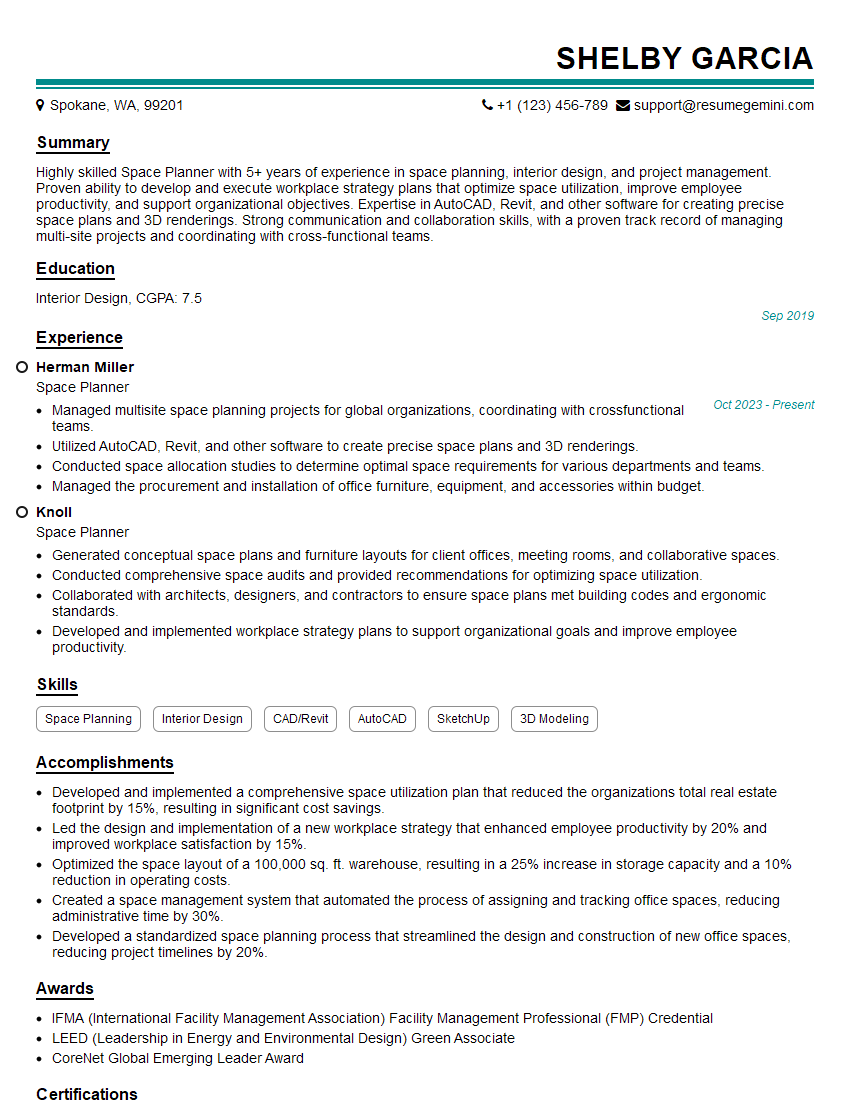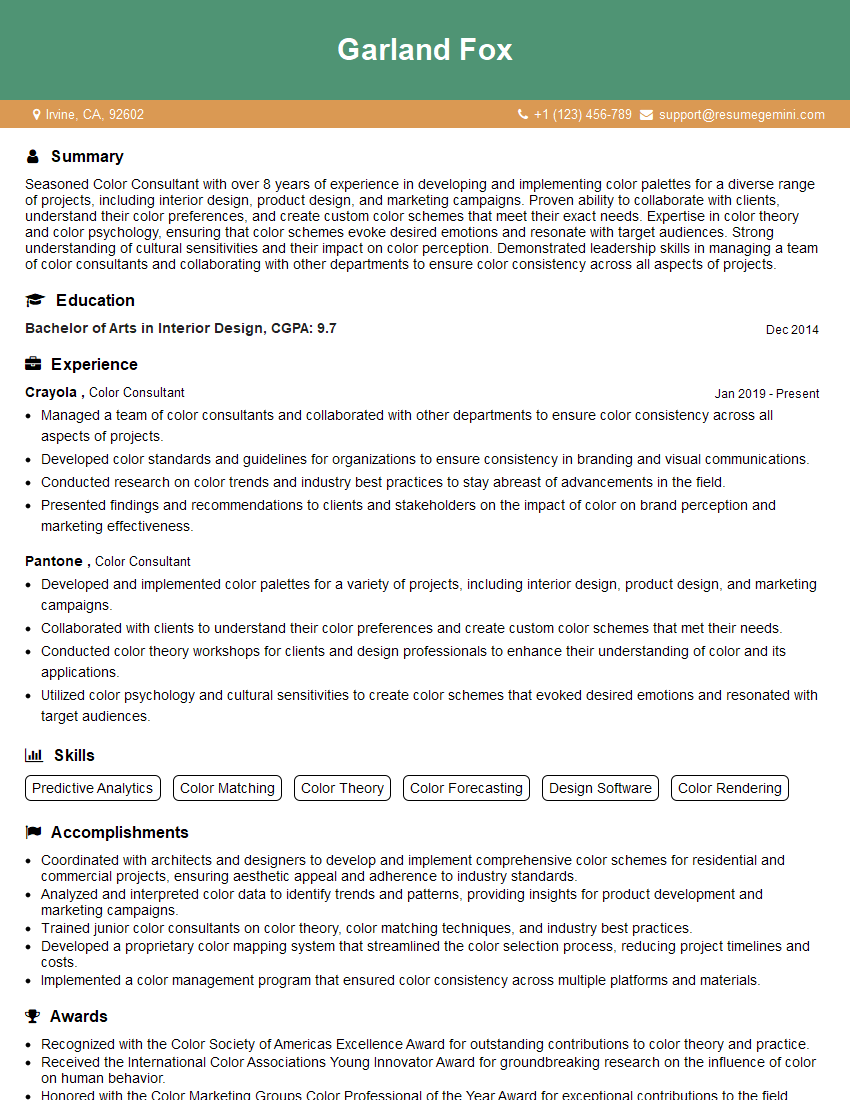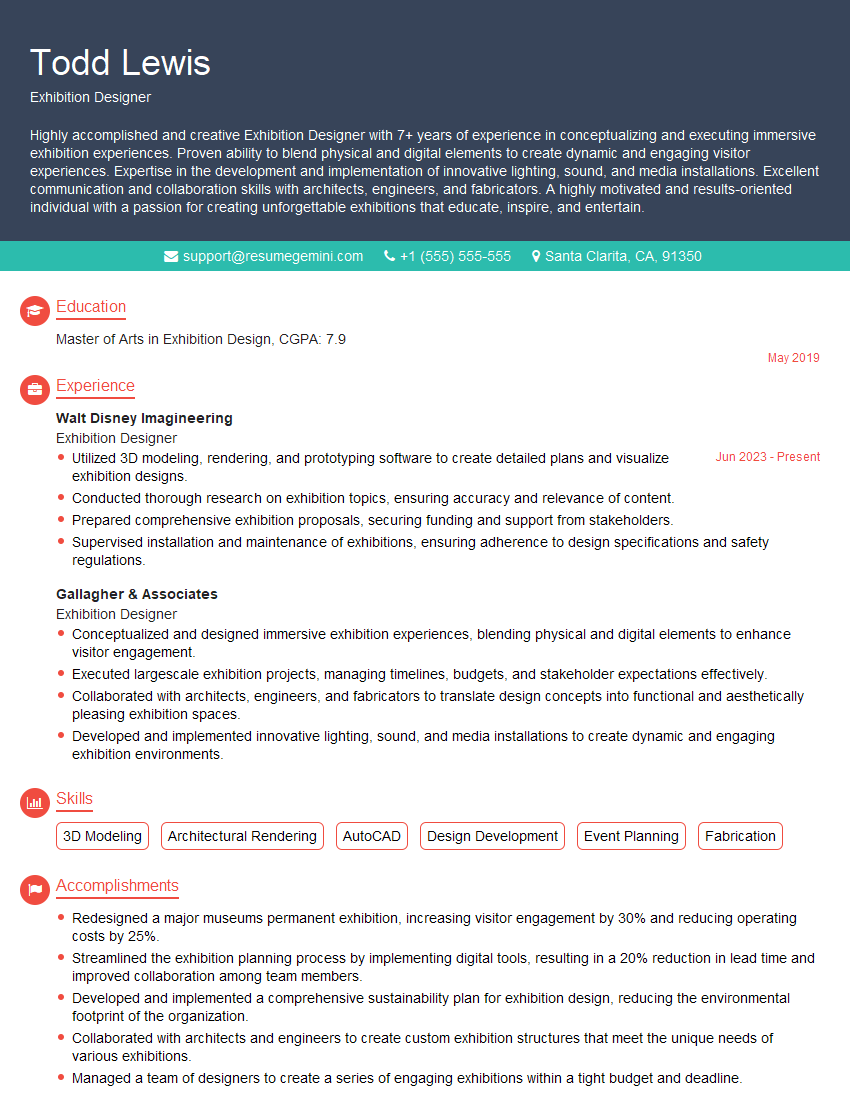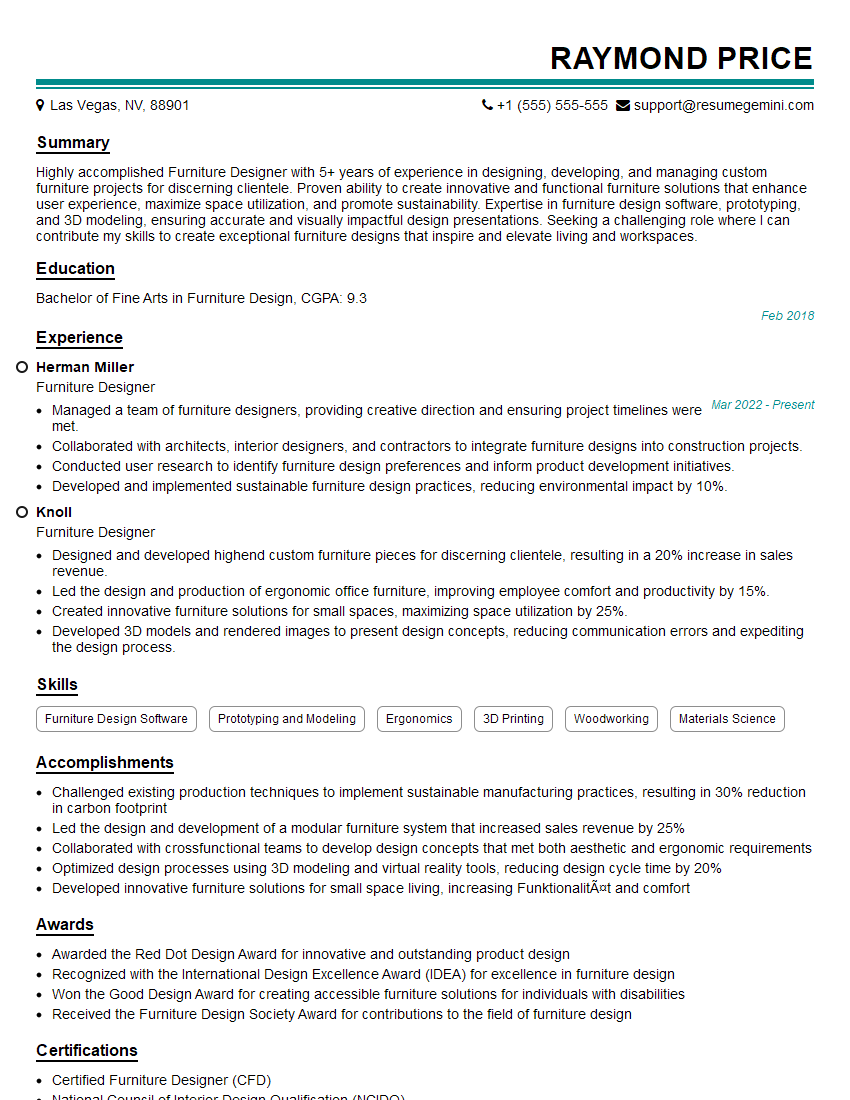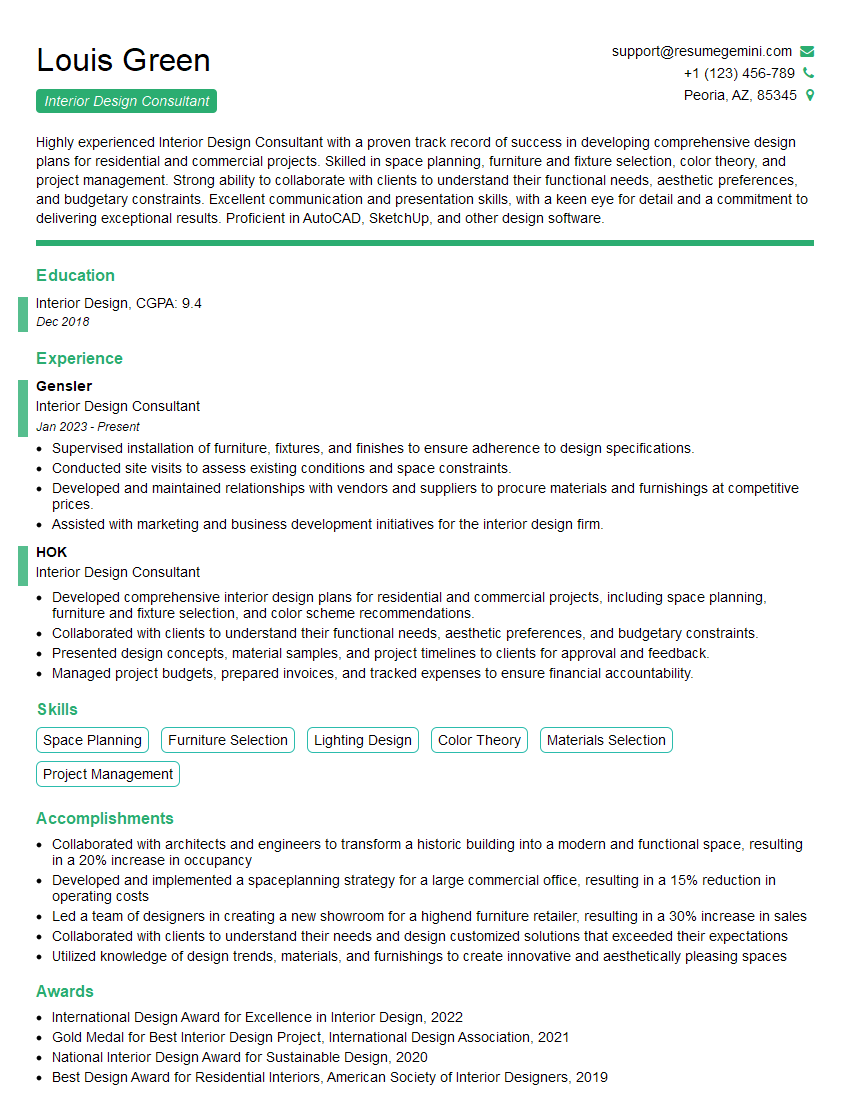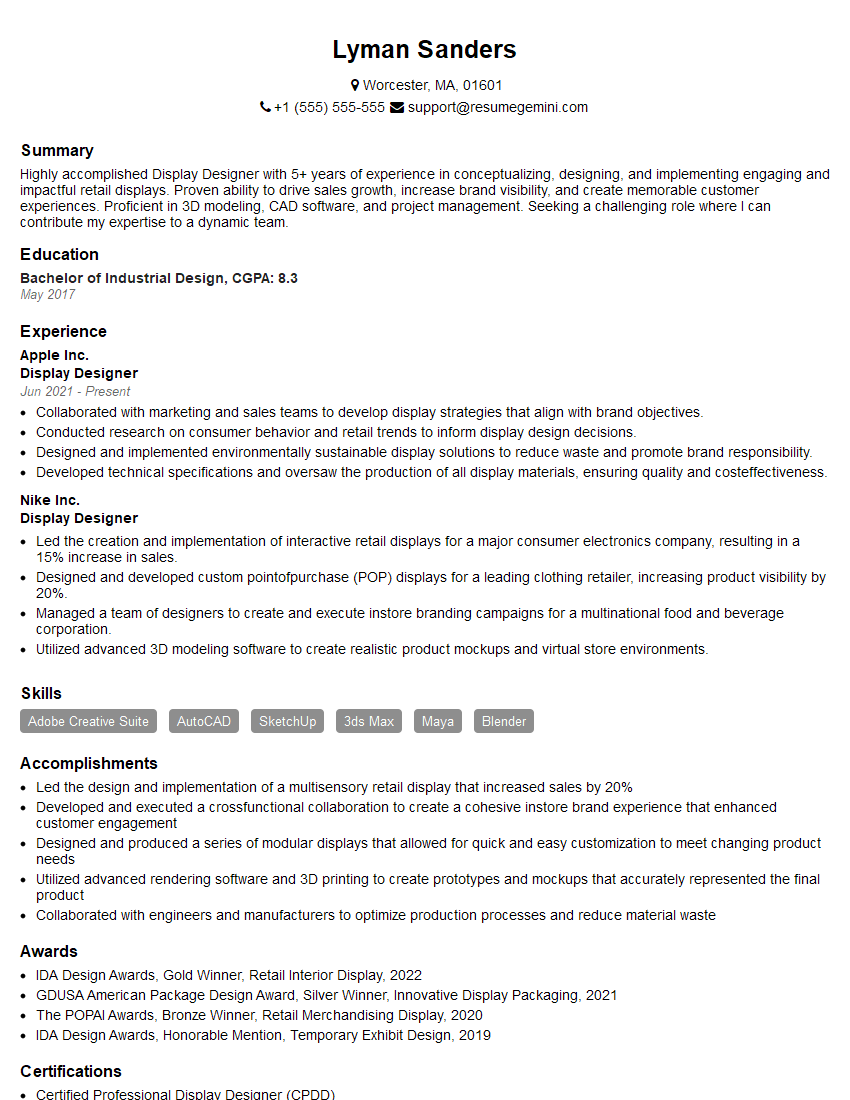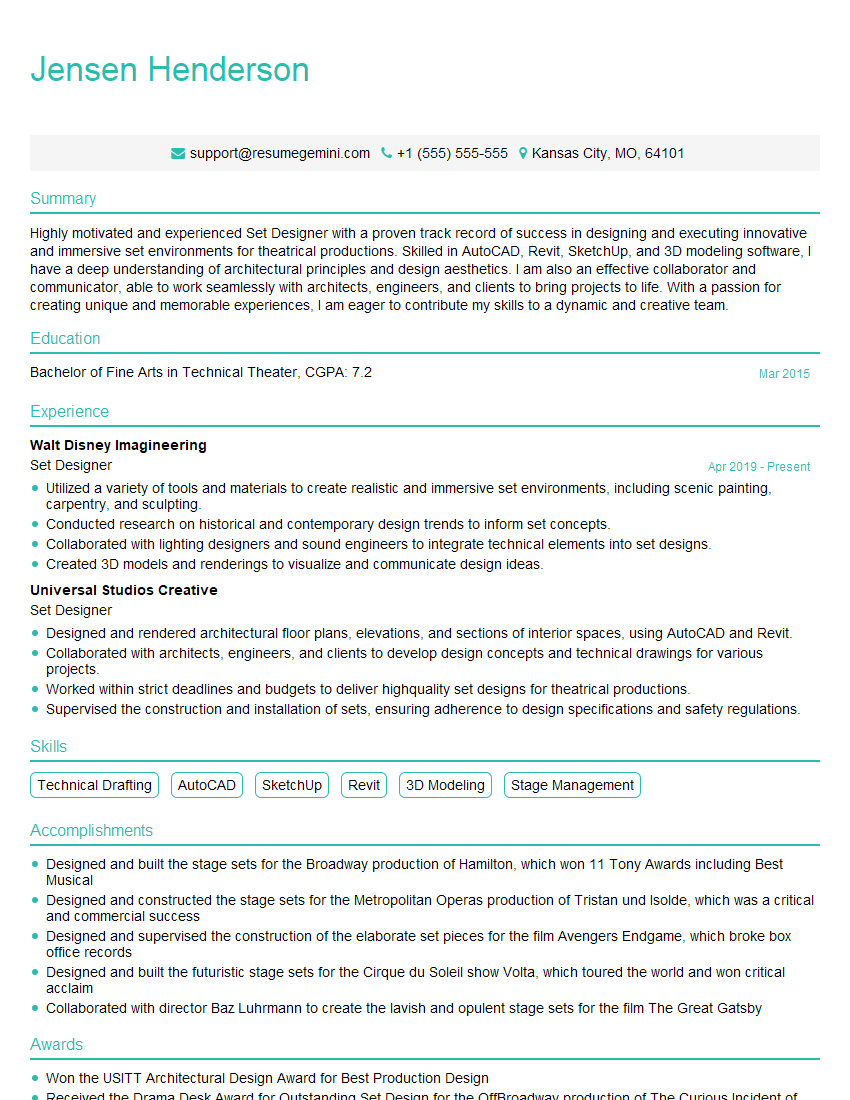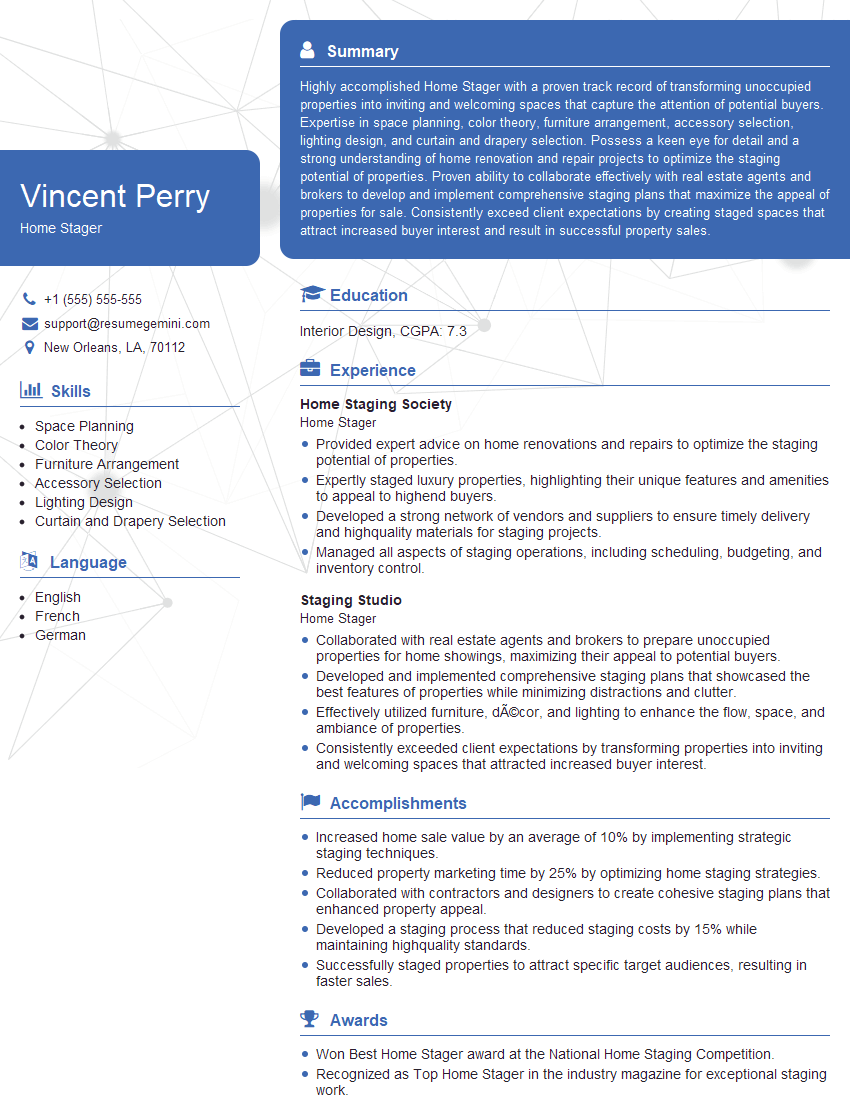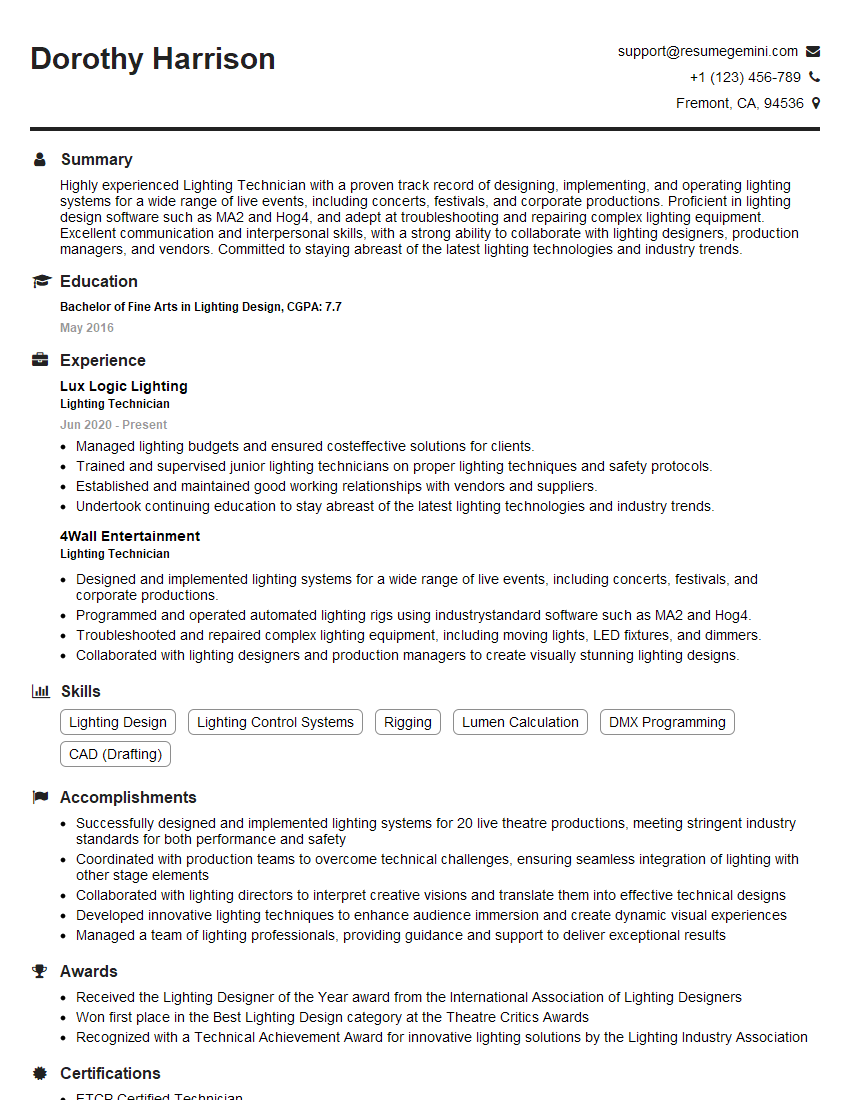Every successful interview starts with knowing what to expect. In this blog, we’ll take you through the top Lighting and Decor interview questions, breaking them down with expert tips to help you deliver impactful answers. Step into your next interview fully prepared and ready to succeed.
Questions Asked in Lighting and Decor Interview
Q 1. Explain the difference between ambient, task, and accent lighting.
Lighting design isn’t just about illuminating a space; it’s about creating the right atmosphere. We achieve this by layering different types of lighting: ambient, task, and accent.
- Ambient Lighting: This is your overall room illumination, providing a general, soft glow. Think of it as the base layer. Examples include ceiling fixtures, recessed lights, or even strategically placed floor lamps. Its purpose is to set the mood and provide comfortable visibility. Imagine a softly lit living room, perfect for relaxing.
- Task Lighting: This is focused light designed for specific activities. Think desk lamps for reading, under-cabinet lighting in the kitchen for food preparation, or pendants over a kitchen island. The key is to eliminate shadows and provide sufficient illumination for the task at hand.
- Accent Lighting: This is used to highlight architectural details, artwork, or decorative objects. It adds drama and visual interest. Examples include track lighting showcasing a sculpture, wall sconces framing a mirror, or strategically placed spotlights on a piece of art. It’s the ‘jewelry’ of your lighting scheme.
Using all three layers creates a balanced and visually appealing space. Imagine a bedroom: ambient lighting from a ceiling fixture provides a soft background, task lighting on the bedside table helps with reading, and accent lighting illuminates a piece of artwork on the wall. This creates a functional and aesthetically pleasing space.
Q 2. Describe your experience with various lighting technologies (LED, incandescent, fluorescent).
My experience spans across a wide range of lighting technologies. Each has its own advantages and disadvantages.
- Incandescent: These bulbs offer warm, inviting light, but they are energy inefficient and have a short lifespan. I mainly use them in specific applications where a warm, soft glow is paramount, often in combination with other more energy-efficient options. Think accent lighting with a vintage feel.
- Fluorescent: These were once a popular choice for their energy efficiency, but they can be bulky, produce a slightly cooler light, and sometimes flicker or hum. They’ve largely been superseded by LEDs but still have a place in certain commercial settings.
- LED: LEDs are the current gold standard. They are incredibly energy-efficient, long-lasting, come in various color temperatures and brightness levels, and offer a wide range of design options – from sleek minimalist fixtures to ornate chandeliers. The ability to precisely control the color temperature and dimming capabilities makes them ideal for nearly any application.
I often combine different technologies in a single design. For instance, I might use LED recessed lights for ambient lighting, LED under-cabinet lights for task lighting, and incandescent bulbs in a statement pendant for warm accent lighting. This approach allows me to tailor the lighting scheme to meet both functional and aesthetic goals.
Q 3. How do you choose the appropriate lighting for different room types (e.g., living room, kitchen, bedroom)?
Lighting selection greatly depends on the function and mood of each room. I approach each space individually, considering its purpose and the desired ambiance.
- Living Room: Requires a layered approach. Ambient lighting from a central fixture, task lighting from floor lamps or table lamps, and accent lighting to highlight artwork or architectural features. The goal is to create a relaxed and inviting atmosphere, adaptable for various activities – reading, conversation, watching TV.
- Kitchen: Needs a combination of strong task lighting (under-cabinet, pendant lights over islands) for food prep and cleaning, and ambient lighting for overall illumination. The lighting should be bright and functional but not harsh.
- Bedroom: Should prioritize a calm and restful atmosphere. Ambient lighting is essential, perhaps with dimmable features to control brightness. Bedside lamps provide task lighting for reading and accent lighting can be used subtly to enhance the room’s character.
I always consider the room’s size, ceiling height, color palette, and overall style when selecting fixtures and determining the placement of light sources. The overall effect should be harmonious and comfortable, tailored to the specific needs of the space and its occupants.
Q 4. Explain your understanding of color temperature and its effect on mood and ambiance.
Color temperature is measured in Kelvin (K) and significantly impacts the mood and ambiance of a space. Lower Kelvin values indicate warmer tones, while higher values represent cooler tones.
- Warm White (2700K-3000K): Creates a cozy and inviting atmosphere, perfect for living rooms, bedrooms, and dining areas. It’s relaxing and conducive to socializing or unwinding.
- Neutral White (3500K-4100K): Offers a balanced and versatile light, suitable for kitchens, bathrooms, and hallways. It’s functional and not too harsh.
- Cool White (5000K-6500K): Provides bright, crisp light, often used in offices or task-oriented areas. It can feel sterile in residential settings if not used carefully.
Consider the room’s function and desired mood. Warm white fosters relaxation, while cool white enhances focus. I often use a combination of color temperatures to achieve a layered effect – warm white for ambient lighting and neutral or cool white for task lighting.
Q 5. How do you incorporate natural light effectively into an interior design scheme?
Maximizing natural light is crucial for energy efficiency and creating a bright, airy space. I employ several strategies:
- Window Treatments: Sheer curtains or blinds allow natural light to filter in while maintaining privacy. Heavier curtains can be used to control light levels and block harsh sunlight.
- Mirror Placement: Strategically placed mirrors can reflect natural light deeper into the room, enhancing brightness and reducing the need for artificial light.
- Light-Colored Walls and Flooring: These reflect light more effectively than dark colors, maximizing the impact of natural light. Think of how a white room feels brighter than a dark one, even with the same amount of sunlight.
- Decluttering and Furniture Arrangement: Avoid obstructing windows with furniture. Arrange furniture to maximize light penetration and reflection.
Careful consideration of window placement and orientation is key during the initial design phase. I always work with architects to ensure optimal natural light ingress.
Q 6. Describe your process for creating a lighting design plan.
My lighting design process is iterative and collaborative:
- Client Consultation: Understanding the client’s needs, preferences, lifestyle, and budget is paramount. We discuss the desired ambiance, functional requirements, and aesthetic goals.
- Space Analysis: I carefully analyze the space, considering its dimensions, ceiling height, architectural features, and existing furniture. I note the locations of windows and existing electrical outlets.
- Lighting Scheme Development: I develop a lighting scheme that incorporates ambient, task, and accent lighting, specifying fixture types, placement, and wattage. I consider the color temperature and dimming options.
- Rendering and Visualization: I use software (see next answer) to create 3D renderings and visualizations, allowing clients to see how the lighting scheme will look and feel.
- Revisions and Refinements: Based on client feedback, I iterate on the design, making adjustments as needed. This is a collaborative process.
- Implementation and Installation: I provide detailed specifications for installation, ensuring proper placement and functionality of all lighting fixtures.
Throughout the process, I maintain open communication with the client, ensuring their vision is realized effectively and efficiently.
Q 7. What software programs are you proficient in for lighting design and visualization?
I’m proficient in several software programs for lighting design and visualization, including:
- Dialux evo: A powerful and widely used software for lighting simulations and calculations. It allows for accurate rendering and helps optimize energy efficiency.
- Autodesk Revit: Integrated into my architectural workflow, Revit allows for seamless coordination between architectural and lighting designs.
- SketchUp: A versatile 3D modeling program used for initial concept development and visualization.
- Adobe Photoshop and Illustrator: Used for creating mood boards, presentations, and detailed technical drawings.
My expertise in these software packages allows me to create detailed, accurate, and visually compelling presentations for my clients, ensuring a clear understanding of the proposed lighting design.
Q 8. Explain your experience with lighting control systems.
My experience with lighting control systems spans a wide range, from basic dimmer switches to sophisticated networked systems. I’m proficient in designing and implementing systems using various technologies, including DMX, DALI, and KNX. I understand the importance of selecting the right system based on project needs, budget, and scalability. For instance, in a large commercial space, a networked system like KNX offers centralized control and energy efficiency, allowing for customized lighting scenes across different zones. In a smaller residential setting, a simpler system with individual dimmer switches might suffice. My expertise extends beyond just installation; I also focus on programming and customizing these systems to meet specific client requirements, including integration with other smart home technologies.
- DMX (Digital Multiplex): Excellent for theatrical and dynamic lighting effects.
- DALI (Digital Addressable Lighting Interface): Ideal for commercial settings needing individual fixture control and monitoring.
- KNX: A robust and versatile system for larger projects, offering extensive integration capabilities.
Beyond the technical aspects, I prioritize user-friendliness. The system should be intuitive and easy for the client to operate, regardless of its complexity. I always consider future expansion and maintainability when designing a lighting control system.
Q 9. How do you balance functionality and aesthetics in your lighting designs?
Balancing functionality and aesthetics in lighting design is crucial. It’s about creating an environment that is both visually appealing and effectively illuminated. I achieve this through careful consideration of several factors. Firstly, I assess the space’s purpose and the activities it will host. A restaurant needs different lighting than a home office. Then, I select fixtures that complement the overall design style, considering material, finish, and size. However, aesthetic choices must never compromise functionality. For example, using beautiful pendant lights in a living room is great, but they also need to provide adequate ambient light. I achieve this by layering light sources: ambient lighting for general illumination, task lighting for specific areas (like a reading nook), and accent lighting to highlight architectural features or artwork. This layering ensures both a pleasing visual impact and adequate light levels for every task.
For example, in a modern minimalist living room, I might use sleek recessed downlights for ambient lighting, complemented by a stylish floor lamp for task lighting and strategically placed track lighting to highlight artwork. This combination provides both functional illumination and a visually cohesive design.
Q 10. Describe your approach to selecting color palettes for interior spaces.
My approach to selecting color palettes for interior spaces involves a holistic understanding of the space’s purpose, its architectural style, and the client’s preferences. I begin by considering the mood and atmosphere I want to create. Warm colors like reds and oranges create a cozy and inviting ambiance, while cool colors like blues and greens offer a calming and serene feel. I also analyze the natural light in the space; a room with abundant natural light can handle richer, deeper colors, whereas a space with limited natural light may benefit from lighter, brighter shades. It is important to test colors on actual walls because colors look dramatically different on small samples than on large surfaces. Furthermore, understanding color theory, such as complementary and analogous color schemes, helps to create harmonious and balanced palettes.
For instance, a client’s preference for earthy tones in a rustic-style kitchen might lead to a palette centered around warm browns, greens, and creams. In contrast, a modern, minimalist office might benefit from a palette of cool grays, whites, and subtle blues. The final decision always involves a collaborative discussion with the client to ensure the chosen palette aligns with their vision and preferences.
Q 11. How do you incorporate different textures and patterns into a design scheme?
Incorporating textures and patterns is key to creating visual interest and depth within a design scheme. I approach this by selecting materials with contrasting textures—for example, pairing smooth, polished surfaces with rough, textured ones. This creates a dynamic interplay of visual elements. The use of patterns, whether in fabrics, wallpapers, or rugs, can add personality and character. However, balance is key; too many patterns can overwhelm a space. I often use a dominant pattern in one area and complement it with smaller, subtler patterns in other areas to maintain visual harmony. The scale of patterns is also crucial; large-scale patterns are ideal for spacious rooms, while small-scale patterns work better in smaller spaces.
For example, in a bedroom, I might use a textured wool rug with a subtle geometric pattern, complemented by smooth silk cushions with a more intricate design. This carefully curated combination of textures and patterns provides a sophisticated and visually engaging atmosphere without feeling cluttered.
Q 12. Explain your understanding of space planning principles.
Space planning principles form the foundation of any successful design project. My understanding involves optimizing the use of space to maximize functionality, aesthetics, and user experience. This starts with understanding the client’s needs and how the space will be used. I then create a layout that efficiently accommodates those needs, considering traffic flow, furniture placement, and the placement of key elements. Factors like scale, proportion, and balance are critical in creating a visually pleasing and functional arrangement. I always strive to create a sense of flow and connection between different areas within the space. For example, in an open-plan living area, the arrangement of furniture will guide the eye from one area to another, creating a sense of continuity.
I also employ different space planning techniques such as zoning (dividing the space into distinct areas for different activities), and the use of focal points to draw the eye and create visual interest. Ultimately, effective space planning is about creating a harmonious and functional environment that meets the client’s needs and enhances their quality of life.
Q 13. How do you manage client expectations and feedback during a project?
Managing client expectations and feedback is paramount to the success of any project. I establish clear communication from the outset, providing realistic timelines and budgets. Regular updates throughout the project ensure transparency and allow for early identification and resolution of potential issues. I actively encourage client feedback at each stage of the design process, using collaborative tools such as mood boards and 3D renderings to visualize the design and gather feedback. I view client feedback as invaluable input, not as criticism. I always approach feedback constructively, explaining design choices and incorporating suggestions where appropriate. Sometimes, however, I may need to gently guide the client towards a solution that better aligns with functionality and feasibility. Ultimately, my goal is to deliver a design that meets the client’s needs and exceeds their expectations, establishing a positive working relationship built on mutual understanding and respect.
Q 14. Describe a challenging lighting project you encountered and how you overcame it.
One challenging project involved designing the lighting for a high-end art gallery with unique architectural features and a vast collection of diverse artwork. The challenge was to create a lighting scheme that showcased each piece effectively while maintaining the gallery’s aesthetic integrity. The initial plan, using standard track lighting, proved inadequate due to its inability to provide the precise control and accentuation required for the varying artwork. To overcome this, we implemented a highly customized system using a combination of track lighting with adjustable spotlights, fiber optic lighting for delicate pieces, and specialized LED systems for specific artworks that required particular color temperatures or intensity. We also had to carefully manage light levels to prevent glare and reflections, which could damage the artwork or obscure details. The project required extensive research and experimentation to select the right lighting fixtures and fine-tune the system to provide the optimal illumination for each piece. The final result was a visually stunning gallery space that not only illuminated the art perfectly but also highlighted its delicate nuances and rich textures. The success was a testament to collaborative problem-solving and the importance of adaptability in a challenging project.
Q 15. How do you stay up-to-date with the latest trends in lighting and interior design?
Staying current in the dynamic fields of lighting and interior design requires a multifaceted approach. I actively engage with several key strategies to ensure I’m at the forefront of the latest trends.
- Industry Publications and Websites: I regularly subscribe to and read leading design magazines like Architectural Digest, Elle Decor, and Interior Design. Online platforms like Dezeen and ArchDaily provide daily updates on emerging trends and innovative projects.
- Trade Shows and Conferences: Attending industry events like Lightfair International and Maison et Objet allows me to experience new products firsthand, network with other professionals, and gain insights into future directions.
- Social Media and Online Communities: Platforms like Pinterest, Instagram, and Behance offer a wealth of visual inspiration and allow me to follow influential designers and brands. I also participate in relevant online forums and communities to engage in discussions and learn from others’ experiences.
- Continuing Education: I actively seek out workshops, webinars, and online courses to deepen my knowledge in specific areas like sustainable lighting technologies or advanced lighting design software.
This multi-pronged approach ensures I remain informed about new materials, technologies, and design aesthetics, allowing me to provide clients with the most up-to-date and relevant design solutions.
Career Expert Tips:
- Ace those interviews! Prepare effectively by reviewing the Top 50 Most Common Interview Questions on ResumeGemini.
- Navigate your job search with confidence! Explore a wide range of Career Tips on ResumeGemini. Learn about common challenges and recommendations to overcome them.
- Craft the perfect resume! Master the Art of Resume Writing with ResumeGemini’s guide. Showcase your unique qualifications and achievements effectively.
- Don’t miss out on holiday savings! Build your dream resume with ResumeGemini’s ATS optimized templates.
Q 16. What are your preferred sources for inspiration?
My inspiration sources are diverse and constantly evolving, mirroring the multifaceted nature of design.
- Nature: I find immense inspiration in the natural world – the play of light and shadow in forests, the vibrant colors of sunsets, the texture of natural materials. This translates directly into design choices, influencing color palettes, material selection, and the overall ambience of a space.
- Art and Culture: Visiting art galleries, museums, and historical sites provides exposure to different aesthetics, periods, and design philosophies. This broadens my creative perspective and fuels my design process.
- Travel: Exploring different cultures and architectural styles exposes me to diverse design approaches and expands my understanding of how light and space can be utilized creatively.
- Architecture and Urban Spaces: Observing the interplay of light and architecture in different urban environments stimulates my creativity and allows me to appreciate the impact of lighting on the overall experience of a space.
- Design Blogs and Portfolios: I actively browse design blogs and online portfolios of established and emerging designers, seeking innovative ideas and approaches to lighting and decor.
By drawing inspiration from diverse sources, I create unique and personalized designs that reflect both current trends and timeless appeal.
Q 17. Explain your understanding of sustainable design principles in lighting and decor.
Sustainable design is paramount in my approach to lighting and décor. It’s not just a trend but a responsible practice crucial for preserving our environment and resources for future generations.
- Energy-Efficient Lighting: I prioritize LED lighting for its energy efficiency, longevity, and reduced carbon footprint. I carefully choose fixtures with high lumens per watt (LPW) ratings, ensuring maximum light output with minimal energy consumption.
- Sustainable Materials: I incorporate materials like reclaimed wood, recycled metals, and sustainably sourced fabrics whenever feasible. This reduces demand on virgin resources and minimizes environmental impact.
- Natural Light Maximization: Designing spaces to maximize natural light reduces the reliance on artificial lighting. This involves strategic window placement, the use of light-colored reflective surfaces, and minimizing obstructions to natural light flow.
- Low-VOC Paints and Finishes: Volatile organic compounds (VOCs) can contribute to indoor air pollution. I specify paints and finishes with low or zero VOC content to create healthier indoor environments.
- Energy-Conscious Design Strategies: I consider the overall energy footprint of the design, considering factors such as thermal performance of materials and the use of smart lighting controls.
By integrating sustainable principles throughout the design process, I create spaces that are both aesthetically pleasing and environmentally responsible.
Q 18. How do you handle budget constraints when designing a lighting scheme?
Budget constraints are a common challenge in design projects. My approach involves a strategic balance of creativity and pragmatism.
- Prioritization: I work closely with clients to establish priorities, identifying essential elements that warrant higher investment and areas where cost-effective alternatives can be explored.
- Value Engineering: I explore various options within different price points. This includes selecting fixtures with similar aesthetic appeal but varying price tags, negotiating with suppliers, or suggesting creative solutions using less expensive materials in strategic ways.
- Mix and Match: Combining high-impact statement pieces with more affordable elements can create a balanced and visually interesting scheme without exceeding the budget.
- DIY and Upcycling: In certain situations, I propose incorporating DIY elements or upcycled materials to add a unique touch and reduce costs. For instance, repurposing old furniture or using reclaimed materials can contribute to cost savings and a sustainable design.
- Phased Implementation: Sometimes, a phased approach is ideal. This allows the client to implement the lighting scheme gradually, aligning with their budget availability over time.
The key is open communication with the client, transparent cost analysis, and creative problem-solving. My goal is to deliver a beautiful and functional lighting scheme while respecting budgetary limitations.
Q 19. What is your experience with different styles of interior design (e.g., modern, traditional, minimalist)?
My experience encompasses a wide range of interior design styles, each with its distinct approach to lighting and décor.
- Modern: Modern style emphasizes clean lines, functionality, and minimalist aesthetics. Lighting choices often include sleek, integrated fixtures, accent lighting to highlight architectural features, and task lighting for specific purposes. The color palettes are usually neutral and sophisticated.
- Traditional: Traditional style evokes a sense of warmth, elegance, and history. Lighting fixtures are often ornate, featuring classic shapes and materials like crystal or brass. Layered lighting is key, incorporating ambient, task, and accent lighting to create a rich and inviting atmosphere.
- Minimalist: Minimalist design focuses on simplicity, functionality, and clean lines. Lighting typically involves concealed or integrated fixtures, avoiding unnecessary ornamentation. The focus is on creating a calm and uncluttered environment with soft, diffused light.
- Transitional: Transitional style blends elements of traditional and modern styles, creating a balanced and harmonious space. Lighting selections reflect this balance, incorporating both contemporary and classic fixtures. The approach seeks to unify disparate design elements.
I adapt my approach to each style, understanding the nuances of each aesthetic and ensuring the lighting complements the overall design concept.
Q 20. How do you incorporate the client’s personal style and preferences into the design?
Incorporating the client’s personal style and preferences is crucial for creating a truly successful design. I start by establishing a strong client relationship based on clear communication and mutual understanding.
- Initial Consultation: This involves thorough discussions to understand their lifestyle, hobbies, aspirations, and design preferences. I explore their visual preferences through mood boards, images, and discussions of their favorite spaces.
- Style Questionnaire: I often use questionnaires to gather detailed information about their taste, preferred colors, materials, and overall aesthetic vision. This detailed approach ensures we’re on the same page.
- Site Visit: A site visit helps to analyze the existing space, considering natural light sources, architectural features, and the overall flow of the room. This informs lighting placement and fixture selection.
- Mood Boards and Concept Development: I develop mood boards showcasing different lighting and décor options aligned with their preferences. This visual representation facilitates open discussion and refinement of the design concept.
- Iterative Feedback: I provide regular updates and solicit feedback throughout the design process, ensuring the final design reflects their individual style and satisfies their needs.
My goal is to create a space that is not only aesthetically pleasing but also reflects the client’s unique personality and lifestyle.
Q 21. Describe your understanding of lighting calculations and energy efficiency.
Understanding lighting calculations and energy efficiency is essential for creating functional and sustainable lighting schemes.
- Illuminance Calculations: These determine the amount of light needed for a given space and activity. Factors like room size, ceiling height, and task requirements influence the required illuminance levels (measured in lux). Software like DIALux evo is commonly used for these calculations.
- Light Level Design: I design lighting schemes considering the different lighting layers: ambient (general illumination), task (focused lighting for specific activities), and accent (highlighting architectural details or artwork). Balancing these layers is crucial for creating a functional and visually appealing space.
- Energy Efficiency Calculations: I assess the energy consumption of different lighting solutions, taking into account factors like wattage, lamp efficiency, and operational hours. This informs decisions about fixture selection and controls.
- Lighting Controls: Incorporating dimming controls, occupancy sensors, and daylight harvesting systems significantly reduces energy waste. These smart technologies optimize energy consumption based on occupancy and available natural light.
- Luminaire Selection: I choose energy-efficient luminaires with high lumens per watt (LPW) ratings and long lifespan. I carefully consider factors such as color rendering index (CRI) to ensure accurate color reproduction.
By conducting thorough calculations and implementing energy-efficient strategies, I ensure the lighting scheme is both aesthetically pleasing and environmentally responsible, minimizing the overall energy footprint of the space.
Q 22. What is your experience with lighting safety regulations and codes?
Lighting safety is paramount in my work. I’m intimately familiar with the National Electrical Code (NEC) and local building codes, which govern everything from fixture installation to wiring techniques. My experience includes ensuring proper grounding, using appropriate voltage ratings for fixtures and wiring, and adhering to safety standards for damp and wet locations. For example, I would never use a standard indoor fixture in a bathroom without a GFCI (Ground Fault Circuit Interrupter) outlet and a fixture rated for damp or wet locations. I regularly inspect installations to ensure compliance, and I’m proficient in identifying and addressing potential hazards. I also stay current on the latest updates to safety regulations through ongoing professional development.
Understanding the implications of non-compliance is crucial. Improper wiring can lead to fire hazards, electrocution, and costly repairs. My rigorous approach to safety ensures not only the longevity of the lighting system but also the safety and well-being of the occupants.
Q 23. Explain your familiarity with different types of lighting fixtures and their applications.
My expertise encompasses a wide range of lighting fixtures, each suited for specific applications. We have:
- Recessed Lighting: Ideal for general illumination, offering a clean, minimalist aesthetic. They are efficient for energy consumption and are perfect for kitchens, hallways, and living rooms.
- Pendant Lights: These create a focal point, often used above dining tables or kitchen islands. The style can range from modern minimalism to ornate chandeliers.
- Track Lighting: Highly versatile, allowing for adjustable light placement. Great for showcasing artwork or highlighting specific architectural features in galleries, showrooms, or retail spaces.
- Chandeliers: Statement pieces adding elegance and grandeur to entryways, dining rooms, or grand staircases. Style and scale must be carefully considered for the space.
- Floor and Table Lamps: Provide ambient lighting and task lighting, enhancing the mood and functionality of a room. They are essential for comfortable reading and creating a warm atmosphere.
- LED Strip Lighting: Excellent for accent lighting, highlighting architectural details, or creating mood lighting underneath cabinets or behind furniture.
The selection process always begins with understanding the client’s needs, the architectural style of the space, and the desired ambiance. I consider factors like light temperature (warm, cool, or daylight), lumen output (brightness), and color rendering index (CRI), which affects how accurately colors are displayed under the light.
Q 24. How do you select appropriate fabrics and materials for interior spaces?
Fabric and material selection is crucial for creating the desired atmosphere and functionality within an interior space. My approach is holistic, considering durability, aesthetics, and the overall design scheme. For example, I would choose durable, stain-resistant fabrics for high-traffic areas like hallways and family rooms. In contrast, luxurious velvets or silks might be more appropriate for a formal living room.
I consider the following factors:
- Durability: Will the fabric withstand daily wear and tear? This is particularly important for furniture upholstery and rugs.
- Maintenance: How easy is it to clean and maintain the fabric or material? This is especially important with families and pets.
- Aesthetics: Does the texture, pattern, and color complement the overall design scheme and lighting?
- Sustainability: Are the materials eco-friendly and ethically sourced?
- Budget: Material cost is always a consideration and needs to balance quality and aesthetic goals.
Selecting the right materials is an iterative process. I often present clients with various samples to help them visualize how different textures and colors will interact with the lighting and overall design.
Q 25. How do you create a cohesive design scheme across different rooms in a house?
Creating a cohesive design scheme across different rooms requires careful planning and attention to detail. The key is to establish a unifying theme—a consistent color palette, style, or material—that ties the spaces together, yet allows each room to have its own personality. This could be achieved using a signature color that appears in different tones or accents throughout the house.
My approach typically involves:
- Developing a Mood Board: This helps visualize the overall style and color palette.
- Selecting a Consistent Color Palette: Using variations of a few key colors creates harmony.
- Repeating Design Elements: Similar patterns, textures, or materials can be used subtly in different rooms.
- Maintaining a Flow Through Transition Spaces: Hallways and entryways act as connectors, their design should bridge the aesthetic between rooms.
- Considering the Architectural Style: The existing architectural features will often inform the design direction.
For example, a modern home might use a neutral color palette with pops of color as accents, while a traditional home could employ richer colors and more ornate details. The unifying thread is the consistent application of the chosen style across different rooms.
Q 26. How do you measure the success of a lighting and decor project?
Measuring the success of a lighting and décor project is multifaceted. It’s not just about the aesthetic appeal but also about its functionality and impact on the client’s lifestyle. Success is defined by achieving the client’s vision and creating a space that is both beautiful and functional.
Key indicators include:
- Client Satisfaction: Positive feedback and expressions of delight indicate success.
- Functionality: Does the lighting provide adequate illumination for all tasks and activities? Does the furniture arrangement enhance usability?
- Aesthetics: Does the space feel cohesive, balanced, and visually appealing? Does it create the desired atmosphere?
- Durability and Longevity: Were high-quality, durable materials selected that will withstand wear and tear?
- Budget Adherence: Was the project completed within the allocated budget?
Post-project surveys, follow-up calls, and even photos of the completed space can provide valuable feedback for evaluating success. Seeing the client enjoy the space is the ultimate measure of a successful project.
Q 27. Describe your experience working collaboratively with other design professionals.
Collaboration is integral to successful design projects. I have extensive experience working with architects, builders, contractors, and other interior designers. I value open communication, mutual respect, and a shared commitment to achieving a common goal. My approach emphasizes clear communication and timely updates.
For instance, during a recent project involving a new restaurant buildout, I worked closely with the architect to ensure the lighting design complemented the overall architectural scheme. I collaborated with the contractor to address any installation challenges and ensure the final installation met all safety and quality standards. I also collaborated with the client to ensure all their needs and preferences were incorporated into the design.
Successful collaboration requires proactive communication, active listening, and the willingness to compromise and find mutually acceptable solutions.
Q 28. What are your salary expectations?
My salary expectations are commensurate with my experience and expertise in the field of lighting and décor. Considering my extensive experience, proven track record, and strong client relationships, I am seeking a competitive salary within the range of [Insert Salary Range Here]. I am open to discussing this further and am confident that my contributions will add significant value to your organization.
Key Topics to Learn for Your Lighting and Decor Interview
- Lighting Principles: Understanding color temperature (Kelvin), CRI (Color Rendering Index), light levels (lumens, lux), and different lighting types (ambient, accent, task).
- Design Aesthetics & Styles: Familiarity with various interior design styles (e.g., modern, minimalist, traditional) and how lighting choices complement them. Practical application: Explaining how you would select lighting to enhance a specific design scheme.
- Space Planning & Illumination Design: Knowledge of how to effectively illuminate different spaces (residential, commercial) considering factors like ceiling height, room size, and intended use. Practical application: Describing your approach to lighting a retail space to maximize product visibility.
- Lighting Technologies: Understanding LED, incandescent, fluorescent, and other lighting technologies, their pros and cons, and energy efficiency considerations.
- Client Communication & Collaboration: Demonstrating the ability to understand client needs, present lighting design solutions, and manage expectations effectively.
- Budgeting & Project Management: Familiarity with lighting project costs, timelines, and resource allocation. Practical application: Explaining your approach to managing a lighting project within a given budget.
- Safety Regulations & Codes: Understanding relevant safety standards and building codes related to lighting installation and design.
- Sustainable Lighting Practices: Knowledge of energy-efficient lighting solutions and environmentally conscious design choices.
- Software Proficiency (if applicable): Demonstrate your skills in relevant design software such as AutoCAD, Revit, Dialux, or other lighting design programs.
Next Steps
Mastering the principles of Lighting and Decor is crucial for career advancement in this dynamic and creative field. A strong understanding of these concepts will significantly enhance your interview performance and open doors to exciting opportunities. To increase your chances of landing your dream job, focus on creating a compelling and ATS-friendly resume that highlights your skills and experience effectively. ResumeGemini is a trusted resource to help you build a professional and impactful resume. They offer examples of resumes tailored to the Lighting and Decor industry to guide you in showcasing your qualifications in the best possible light. Take advantage of these resources to present yourself as the ideal candidate.
Explore more articles
Users Rating of Our Blogs
Share Your Experience
We value your feedback! Please rate our content and share your thoughts (optional).
